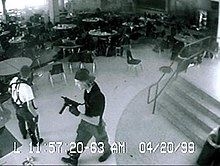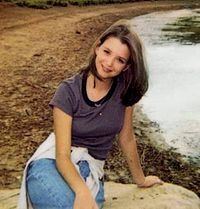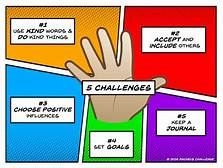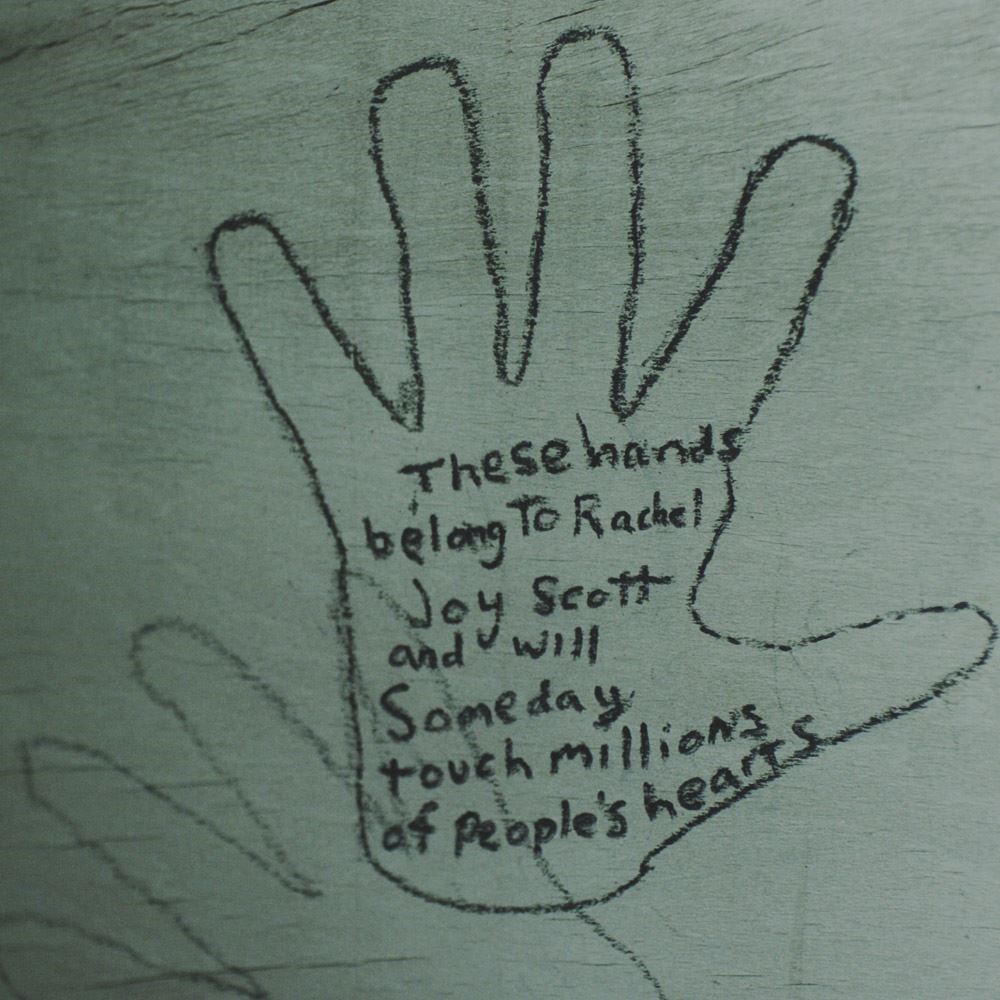Rachel Joy Scott : Students' Hero
Written by: Kyle Vittali from San Diego
 Camera footage of the two shootersen.wikipedia.org
Camera footage of the two shootersen.wikipedia.org Rachel Joy Scotten.wikipedia.orgOne of the nation’s most deadliest mass shootings, located in Columbine High School, which had a total of fifteen deaths which included the shooters themselves. Among those fallen victims was Rachel Joy Scott who was eating lunch with a friend and was the first to be shot among the thirteen fallen victims. Rachel was a faithful young student at the age of 17. Before, she went to Columbine High School and was teased for having a passion in religion. At the time of the shooting, Rachel took her last breath in 1999 at the bottom of a hill when she was getting back up. She had six diaries and one outstanding essay found in her room and in her school after her death. This led Rachel’s family to make a program named “Rachel’s Challenge” in honor of her death and others’ casualties, as well as the morals the diaries and the essay holds. Although Rachel Joy Scott was mocked by her classmates in Columbine, through her essay she believed people had some good in them and had the power to spread a little kindness everywhere. Rachel endured the name-calling and the aggressive acts of others. Despite of these conditions in her high school years, she was emotionally strong like a superhero. A hero must possess empathy, generosity and keeping a goal in mind with these characteristics. Empathy is understanding the emotion of another, which leads to the hero’s generosity to the person. This is when the individual makes acceptable change in someone’s life. The goal with this domino effect must be favorable, because deeds like doing generous acts without expectation of reward or recognition is an agreeable behavior. Rachel Joy Scott is a one-of-a-kind hero that touched millions of hearts through compassion and kindness and with good purpose.
Rachel Joy Scotten.wikipedia.orgOne of the nation’s most deadliest mass shootings, located in Columbine High School, which had a total of fifteen deaths which included the shooters themselves. Among those fallen victims was Rachel Joy Scott who was eating lunch with a friend and was the first to be shot among the thirteen fallen victims. Rachel was a faithful young student at the age of 17. Before, she went to Columbine High School and was teased for having a passion in religion. At the time of the shooting, Rachel took her last breath in 1999 at the bottom of a hill when she was getting back up. She had six diaries and one outstanding essay found in her room and in her school after her death. This led Rachel’s family to make a program named “Rachel’s Challenge” in honor of her death and others’ casualties, as well as the morals the diaries and the essay holds. Although Rachel Joy Scott was mocked by her classmates in Columbine, through her essay she believed people had some good in them and had the power to spread a little kindness everywhere. Rachel endured the name-calling and the aggressive acts of others. Despite of these conditions in her high school years, she was emotionally strong like a superhero. A hero must possess empathy, generosity and keeping a goal in mind with these characteristics. Empathy is understanding the emotion of another, which leads to the hero’s generosity to the person. This is when the individual makes acceptable change in someone’s life. The goal with this domino effect must be favorable, because deeds like doing generous acts without expectation of reward or recognition is an agreeable behavior. Rachel Joy Scott is a one-of-a-kind hero that touched millions of hearts through compassion and kindness and with good purpose.
 The 5 challenge included in Rachel's Challengehttps://rachelschallenge.orgRachel’s kind acts roots from her compassion for others. Her actions can be determined through Rachel’s Challenge which was established by her parents in honor of her death and others’ death, which includes, “...to end prejudice by looking for what's good in others outside your own circle; To dare to dream by setting goals; To look for and choose positive influences; To offer kind words and other acts of kindness; And to start a chain reaction with family and friends”("Editorial: Kindness in Class of Its Own at UHS”). The quote mentions the challenges in “Rachel’s Challenge”, which is an organization whose goal is to reduce violence. The organization emphasizes Rachel’s acts before the violent school shooting. These challenges show her kindness and compassion for positive change. Rachel was concerned for the people she meets and does charitable acts for them, because she thinks that acts of kindness can do great change for people, like when she defended a handicapped student from bullying and prevented a death from suicide. Rachel’s essay, “My Ethics, My Codes of Life,” contain one the most memorable principles one may learn from her. As Brown says, “The Columbine High School student once wrote, 'I have this theory that if one person can go out of their way to show compassion, then it will start a chain reaction of the same. People will never know how far a little kindness can go’"(Brown, par. 14). Brown wanted to share what Rachel’s theory was. Rachel talks about compassion and by utilizing this tool, it results to acts of kindness, which can positively impact people included in the chain reaction. If Rachel can fulfill the theory herself, then we can say she is empathic. She was never popular in school for her actions, everyone ignored her for what she believes in but she showed compassion for the students in her school. In turn, she did acts of kindness despite how her classmates have treated her for her faith. Rachel’s kindness was also shown, especially with her unselfish mind, through her generous and caring acts for other people, “Rachel was anything but selfish, going out of her way to reach out to the less fortunate, spreading her kindness everywhere”(Huang 16). In the quote stated by Huang, Rachel is the type that reaches out not only the ones close to her, but also the ones that are strangers to her. Rachel thinks one act of kindness can be considered a great act, especially when it has spread to other people. She does noble acts whenever she can, especially with her capacity of empathy for the less fortunate. These indicators of her compassion can lead people into thinking about her empathic mind. With her compassion, she went on and started making positive change in people’s lives and continues today through “Rachel’s Challenge”.
The 5 challenge included in Rachel's Challengehttps://rachelschallenge.orgRachel’s kind acts roots from her compassion for others. Her actions can be determined through Rachel’s Challenge which was established by her parents in honor of her death and others’ death, which includes, “...to end prejudice by looking for what's good in others outside your own circle; To dare to dream by setting goals; To look for and choose positive influences; To offer kind words and other acts of kindness; And to start a chain reaction with family and friends”("Editorial: Kindness in Class of Its Own at UHS”). The quote mentions the challenges in “Rachel’s Challenge”, which is an organization whose goal is to reduce violence. The organization emphasizes Rachel’s acts before the violent school shooting. These challenges show her kindness and compassion for positive change. Rachel was concerned for the people she meets and does charitable acts for them, because she thinks that acts of kindness can do great change for people, like when she defended a handicapped student from bullying and prevented a death from suicide. Rachel’s essay, “My Ethics, My Codes of Life,” contain one the most memorable principles one may learn from her. As Brown says, “The Columbine High School student once wrote, 'I have this theory that if one person can go out of their way to show compassion, then it will start a chain reaction of the same. People will never know how far a little kindness can go’"(Brown, par. 14). Brown wanted to share what Rachel’s theory was. Rachel talks about compassion and by utilizing this tool, it results to acts of kindness, which can positively impact people included in the chain reaction. If Rachel can fulfill the theory herself, then we can say she is empathic. She was never popular in school for her actions, everyone ignored her for what she believes in but she showed compassion for the students in her school. In turn, she did acts of kindness despite how her classmates have treated her for her faith. Rachel’s kindness was also shown, especially with her unselfish mind, through her generous and caring acts for other people, “Rachel was anything but selfish, going out of her way to reach out to the less fortunate, spreading her kindness everywhere”(Huang 16). In the quote stated by Huang, Rachel is the type that reaches out not only the ones close to her, but also the ones that are strangers to her. Rachel thinks one act of kindness can be considered a great act, especially when it has spread to other people. She does noble acts whenever she can, especially with her capacity of empathy for the less fortunate. These indicators of her compassion can lead people into thinking about her empathic mind. With her compassion, she went on and started making positive change in people’s lives and continues today through “Rachel’s Challenge”.
One of the characteristics Rachel held dominantly was her positive sense of purpose. Her motives can be seen from her essay, “My Ethics, My Codes of Life”, an excerpt from her essay read, “‘I have this theory that if one person can go out of their way to show compassion, then it will start a chain reaction of the same. People will never know how far a little kindness can go. My codes may seem like a fantasy that can never be reached, but test them for yourself and see what kind of effect they have on people around you. You may just start a chain reaction’"(Long, par. 14). Rachel wanted to show that kindness is something that can be passed on. Her charitable acts has good intent because of the power it holds. She believed that an individual’s path is lit with empathy through compassion. As a result, her purpose caused a chain reaction of kindness. Rachel wanted to be a positive impact to the world by begging “...Him for the chance to show others the way, to let her life have some purpose in spreading His word”(Shepard, par. 5). Rachel asked for a purpose from God, referred to as Him, to positively impact people’s lives through the word of God. The Bible holds all what an individual needs to know about doing good deeds in any circumstance. With the Gospel, Rachel wanted to lead the way and to be a role model of kind acts. She believes that people have the power to make a positive change in a chain reaction of kindness. Thus, her prayers to God make up the sense of purpose in her life. Today, she touched millions of people’s hearts by doing generous and charitable acts through compassion. With her intended purpose, she is a hero and her chain reaction still continues today.
 Rachel's hands drawn in her roomwww.briandoddonleadership.comDespite the hardships an inpidual may face, Rachel Joy Scott truly has the characteristics of a hero with her sense of purpose including kindness and compassion for others. Rachel’s compassion for the less fortunate prompted her to make positive change through a chain reaction of kindness. The effect of these characteristics were driven by her sense of purpose. According to Rachel’s beliefs, kindness and compassion can spread everywhere and touch millions of people’s hearts, which drove her to do empathic acts. Meaning she wanted to use her characteristics for the good of others. Appreciating Rachel’s acts, Huang wrote examples of her kind and compassionate deeds that had inspired millions of people including myself such as “ When a student was bullied and tormented for being handicapped, it was Rachel who stepped up and shielded him from further harassment. When a suicidal teenager was ready to take his life, Rachel was there to befriend him and prevent a death. When a stranger walked into McDonald’s to find shelter from the cold, Rachel did not hesitate to buy a meal for him. Touched by her sympathy and love, lives have been changed by Rachel Joy Scott”(Huang 16). People’s lives were changed through Rachel’s compassion as shown in the examples stated by the author. It was her dream to touch lives by doing these examples to other people. Her touch inspired other people to do more acts of empathy, like her theory about what kindness can do. Rachel inspired the people in the example stated by the author to continue the chain reaction she started. Rachel has also inspired my heart, and I have been a tool for making the chain reaction of kindness. Even after her death, she was able to inspire more people than she had imagined. Until today, her examples of her wonderful acts have changed the lives of millions of people, through empathy and purpose.
Rachel's hands drawn in her roomwww.briandoddonleadership.comDespite the hardships an inpidual may face, Rachel Joy Scott truly has the characteristics of a hero with her sense of purpose including kindness and compassion for others. Rachel’s compassion for the less fortunate prompted her to make positive change through a chain reaction of kindness. The effect of these characteristics were driven by her sense of purpose. According to Rachel’s beliefs, kindness and compassion can spread everywhere and touch millions of people’s hearts, which drove her to do empathic acts. Meaning she wanted to use her characteristics for the good of others. Appreciating Rachel’s acts, Huang wrote examples of her kind and compassionate deeds that had inspired millions of people including myself such as “ When a student was bullied and tormented for being handicapped, it was Rachel who stepped up and shielded him from further harassment. When a suicidal teenager was ready to take his life, Rachel was there to befriend him and prevent a death. When a stranger walked into McDonald’s to find shelter from the cold, Rachel did not hesitate to buy a meal for him. Touched by her sympathy and love, lives have been changed by Rachel Joy Scott”(Huang 16). People’s lives were changed through Rachel’s compassion as shown in the examples stated by the author. It was her dream to touch lives by doing these examples to other people. Her touch inspired other people to do more acts of empathy, like her theory about what kindness can do. Rachel inspired the people in the example stated by the author to continue the chain reaction she started. Rachel has also inspired my heart, and I have been a tool for making the chain reaction of kindness. Even after her death, she was able to inspire more people than she had imagined. Until today, her examples of her wonderful acts have changed the lives of millions of people, through empathy and purpose.
Works Cited
Brown, Brent. "Columbine Victim's Legacy Examined in Free Community Event." Greensburg Daily News (IN), 12 Sept. 2015. EBSCOhost, search.ebscohost.com/login.aspx?direct=true&db=nfh&AN=2W61152579662&site=ehost-live.
"EDITORIAL: Kindness in Class of Its Own at UHS: Friends of Rachel Club Making Difference One Person at a Time." Dominion Post, the (Morgantown, WV), 27 Dec. 2007. EBSCOhost, search.ebscohost.com/login.aspx?direct=true&db=nfh&AN=2W62W6542572628&site=ehost-live.
Huang, Jessica. "Rachel Joy Scott." Teen Ink, vol. 20, no. 8, Apr. 2009, p. 16. EBSCOhost, search.ebscohost.com/login.aspx?direct=true&db=ulh&AN=38708127&site=ehost-live.
Long, Sonny. "'YOU MAY JUST START a CHAIN REACTION': Sister of Columbine Victim Challenges Cuero Students to Accept Rachel's Code." Victoria Advocate (TX), 22 Mar. 2007. EBSCOhost, search.ebscohost.com/login.aspx?direct=true&db=nfh&AN=2W62W63254873962&site=ehost-live.
Shepard, C. Rachel Joy Scott, acolumbinesite.com/victim/rachel.php.
Page created on 2/13/2018 8:19:24 PM
Last edited 9/2/2021 11:27:15 PM
